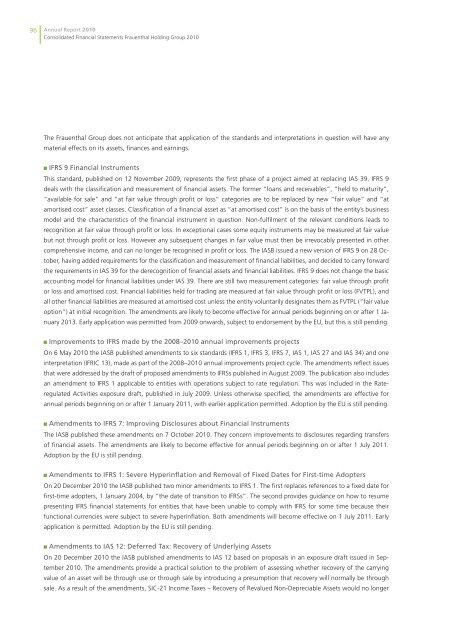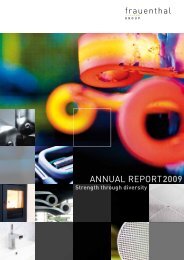Annual Report 2010 - Frauenthal Holding AG
Annual Report 2010 - Frauenthal Holding AG
Annual Report 2010 - Frauenthal Holding AG
You also want an ePaper? Increase the reach of your titles
YUMPU automatically turns print PDFs into web optimized ePapers that Google loves.
96 <strong>Annual</strong> <strong>Report</strong> <strong>2010</strong><br />
Consolidated Financial Statements <strong>Frauenthal</strong> <strong>Holding</strong> Group <strong>2010</strong><br />
The <strong>Frauenthal</strong> Group does not anticipate that application of the standards and interpretations in question will have any<br />
material effects on its assets, finances and earnings.<br />
IFRS 9 Financial Instruments<br />
This standard, published on 12 November 2009, represents the first phase of a project aimed at replacing IAS 39. IFRS 9<br />
deals with the classification and measurement of financial assets. The former “loans and receivables”, “held to maturity”,<br />
“available for sale” and “at fair value through profit or loss” categories are to be replaced by new “fair value” and “at<br />
amortised cost” asset classes. Classification of a financial asset as “at amortised cost” is on the basis of the entity’s business<br />
model and the characteristics of the financial instrument in question. Non-fulfilment of the relevant conditions leads to<br />
recognition at fair value through profit or loss. In exceptional cases some equity instruments may be measured at fair value<br />
but not through profit or loss. However any subsequent changes in fair value must then be irrevocably presented in other<br />
comprehensive income, and can no longer be recognised in profit or loss. The IASB issued a new version of IFRS 9 on 28 October,<br />
having added requirements for the classification and measurement of financial liabilities, and decided to carry forward<br />
the requirements in IAS 39 for the derecognition of financial assets and financial liabilities. IFRS 9 does not change the basic<br />
accounting model for financial liabilities under IAS 39. There are still two measurement categories: fair value through profit<br />
or loss and amortised cost. Financial liabilities held for trading are measured at fair value through profit or loss (FVTPL), and<br />
all other financial liabilities are measured at amortised cost unless the entity voluntarily designates them as FVTPL (“fair value<br />
option”) at initial recognition. The amendments are likely to become effective for annual periods beginning on or after 1 January<br />
2013. Early application was permitted from 2009 onwards, subject to endorsement by the EU, but this is still pending.<br />
Improvements to IFRS made by the 2008–<strong>2010</strong> annual improvements projects<br />
On 6 May <strong>2010</strong> the IASB published amendments to six standards (IFRS 1, IFRS 3, IFRS 7, IAS 1, IAS 27 and IAS 34) and one<br />
interpretation (IFRIC 13), made as part of the 2008–<strong>2010</strong> annual improvements project cycle. The amendments reflect issues<br />
that were addressed by the draft of proposed amendments to IFRSs published in August 2009. The publication also includes<br />
an amendment to IFRS 1 applicable to entities with operations subject to rate regulation. This was included in the Rateregulated<br />
Activities exposure draft, published in July 2009. Unless otherwise specified, the amendments are effective for<br />
annual periods beginning on or after 1 January 2011, with earlier application permitted. Adoption by the EU is still pending.<br />
Amendments to IFRS 7: Improving Disclosures about Financial Instruments<br />
The IASB published these amendments on 7 October <strong>2010</strong>. They concern improvements to disclosures regarding transfers<br />
of financial assets. The amendments are likely to become effective for annual periods beginning on or after 1 July 2011.<br />
Adoption by the EU is still pending.<br />
Amendments to IFRS 1: Severe Hyperinflation and Removal of Fixed Dates for First-time Adopters<br />
On 20 December <strong>2010</strong> the IASB published two minor amendments to IFRS 1. The first replaces references to a fixed date for<br />
first-time adopters, 1 January 2004, by “the date of transition to IFRSs”. The second provides guidance on how to resume<br />
presenting IFRS financial statements for entities that have been unable to comply with IFRS for some time because their<br />
functional currencies were subject to severe hyperinflation. Both amendments will become effective on 1 July 2011. Early<br />
application is permitted. Adoption by the EU is still pending.<br />
Amendments to IAS 12: Deferred Tax: Recovery of Underlying Assets<br />
On 20 December <strong>2010</strong> the IASB published amendments to IAS 12 based on proposals in an exposure draft issued in September<br />
<strong>2010</strong>. The amendments provide a practical solution to the problem of assessing whether recovery of the carrying<br />
value of an asset will be through use or through sale by introducing a presumption that recovery will normally be through<br />
sale. As a result of the amendments, SIC-21 Income Taxes – Recovery of Revalued Non-Depreciable Assets would no longer




